DAVID PARK, 1911–1960
THE EARLY YEARS
“A sensitive, odd, charming boy.”
LOUISA R. ALGER, teacher, in Paul Mills, The New Figurative Art of David Park (Santa Barbara, CA: Capra Press, 1988).
“A slow blossomer, almost a black sheep. He would debate about his future: would he be a painter? . . . or a pianist?”
EDITH PARK TRUESDELL, David Park’s aunt (Ibid.).
Born in Boston, Massachusetts, on March 17, 1911, David Park grows up in a lively, educated family. When he is four or five years old his mother notices that he draws in perspective. He attends prep school at Loomis Academy and leaves during his sophomore year, moving to Los Angeles with his aunt, Edith Park Truesdell, a painter. In 1928 he attends Otis Art Institute in Los Angeles for one year, and then moves to the San Francisco Bay Area. There he becomes friends with fellow artist and student Gordon Newell. Both work as stonecutters for sculptor Ralph Stackpole’s monumental columns in front of the Pacific Stock Exchange. Inside the Exchange, Diego Rivera is painting a mural. Park meets many artists who come to see Rivera, and he becomes part of the San Francisco art community.
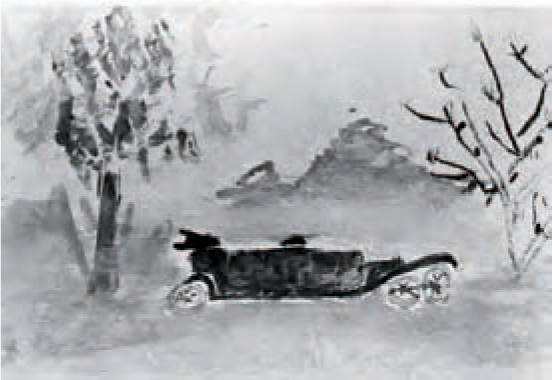
Black Car, 1917 (fig. 5)
THE 1930s
“The Parks brought music and art, all that sort of thing, with them wherever they went.”
HOWARD BAKER, close friend, in exhibition catalogue David Park (1911–1960) (New York: Salander-O’Reilly Galleries, 1987).
In the 1930s, David Park’s first decade as an independent adult, he meets and marries Gordon Newell’s sister, Lydia, known to all as Deedie. They move to Berkeley, where two daughters are born, Natalie in 1931 and Helen in 1933. Park teaches painting classes at private schools and at the University of California Extension Division. With WPA support, he paints a mural for the infirmary at UC Berkeley and eleven large panels of a frieze intended for the music building at Mills College in Oakland. In 1936, in the midst of the Great Depression, Park is appointed head of the art department at Winsor School in Boston, and the family moves to Brookline, Massachusetts. During the 1930s Park is given solo shows at East-West Gallery, San Francisco; Oakland Art Gallery; San Francisco Museum of Art; Delphic Studios, New York; and New Gallery, Boston. His work appears in group shows at the San Francisco Museum of Art. Toward the end of the decade, his subject matter moves from figures in detailed backgrounds to more highly stylized works that reflect the influence of Picasso.

Three Violinists and Dancers 1933–37 (fig. 13)
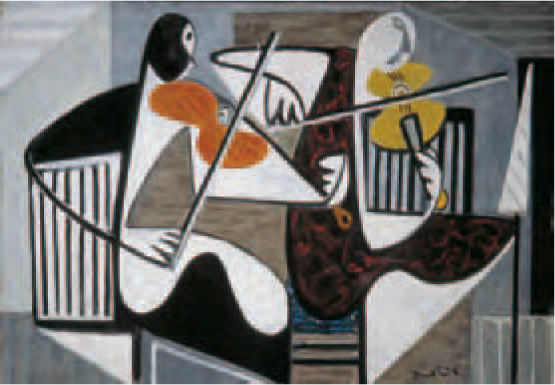
Two Violinists, c. 1938–39 (fig. 16)
THE 1940s
“I met David Park in 1946 at the California School of Fine Arts where he was a teacher and I was a student. . . . I knew at this meeting that the man was extraordinary—and in the ensuing years I was not proven wrong.”
RICHARD DIEBENKORN, in exhibition catalogue David Park (1911–1960) (New York: Salander-O’Reilly Galleries, 1987).
“David was keen on abstract expressionism as long as it had that immediacy and tangibility and sensuous goopiness.”
ELMER BISCHOFF, in Paul Mills, The New Figurative Art of David Park (Santa Barbara, CA: Capra Press, 1988).
In 1941 Park and his family move back to Berkeley, and soon World War II dictates Park’s personal and professional choices. Owing to wartime shortages, his paintings are fewer and smaller. In order to have daylight hours for painting, he works the graveyard shift at a defense plant. He teaches part time at the California School of Fine Arts (CSFA), now San Francisco Art Institute, where he becomes good friends with Richard Diebenkorn, Elmer Bischoff, and Hassel Smith. In 1945 the war ends and the GI Bill brings a flush of young painters to CSFA. Along with other faculty members and students, Park plays in a Dixieland jazz band. Now teaching full time, he and his peers and students all explore Abstract Expressionism. In 1946 he is given a solo show at the California Palace of the Legion of Honor, San Francisco. In 1948 Park, Bischoff, and Smith are exhibited at the San Francisco Museum of Art. At the Berkeley city dump, in 1949, he throws away all his nonobjective work. He returns to the figure as subject matter.
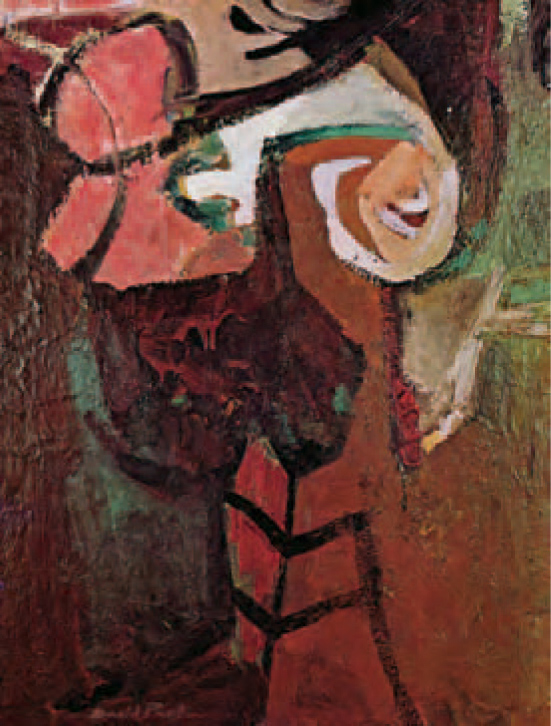
Still Life—Non-Objective 1949 (fig. 33)
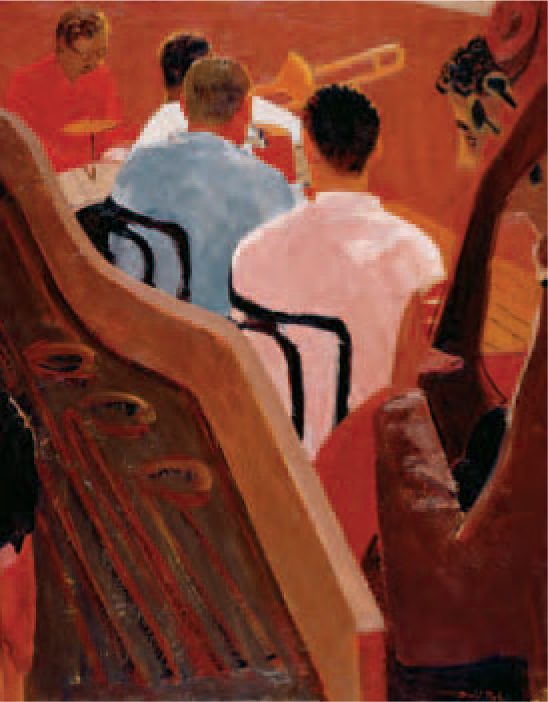
Rehearsal, 1949–1950 (fig. 34)
THE 1950s
“Park’s greatest work, which by my reckoning starts in the mid-1950s, is raked and blistered with all sorts of beautiful conflict.”
W. S. DI PIERO, in exhibition catalogue David Park, A Singular Humanity (San Francisco: Hackett-Freedman Gallery, 2003).
“Art ought to be a troublesome thing.”
DAVID PARK, in exhibition catalogue Bay Area Figurative Painting (Oakland: Oakland Art Museum, 1957).
This is David Park’s last and greatest decade. In 1952 he resigns from the faculty of CSFA. Aided by what he calls The Lydia Park Fellowship—and therefore unencumbered by a job—he paints every day. In 1951 his Kids on Bikes is shown and published. It sets him apart from the Abstract Expressionist work of his peers and shocks both his painter friends and the critics. By the mid-1950s Diebenkorn, Bischoff, and many other colleagues and students have also turned to the figure as subject matter. The term Bay Area Figurative Painting is coined. In 1955 Park is invited to join the faculty of the Art Department at the University of California, Berkeley. Some of the many venues for solo exhibitions during the fifties are the King Ubo Gallery, San Francisco; Paul Kantor Gallery, Los Angeles; Richmond Art Center, Richmond, CA; School of Architecture, University of California, Berkeley; M. H. de Young Memorial Museum, San Francisco; and Staempfli Gallery, New York. His work appears in group shows at the San Francisco Museum of Art; M. H. de Young Memorial Museum; University of Illinois, Urbana-Champaign; Museu de Arte Moderna, São Paulo, Brazil; The Oakland Museum; Minneapolis Institute of Arts; Virginia Museum of Fine Arts, Richmond; Whitney Museum of American Art, New York; and The Detroit Institute of Arts. For the last months of 1959 Park suffers severe back pain and completes his last oil painting, The Cellist.
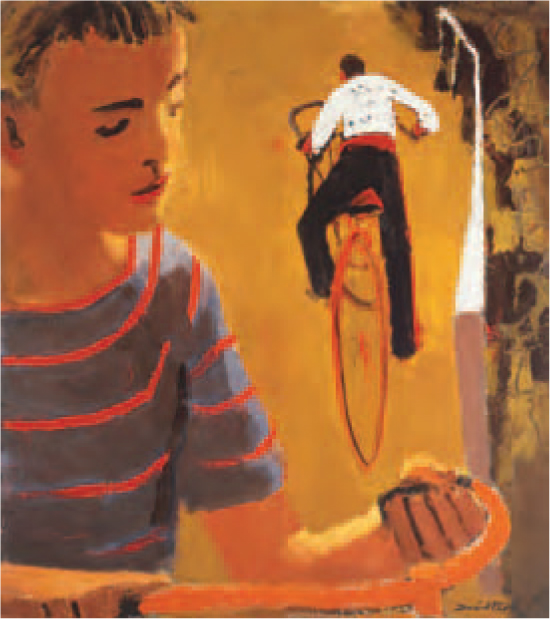
Kids on Bikes, 1950 (fig. 38)
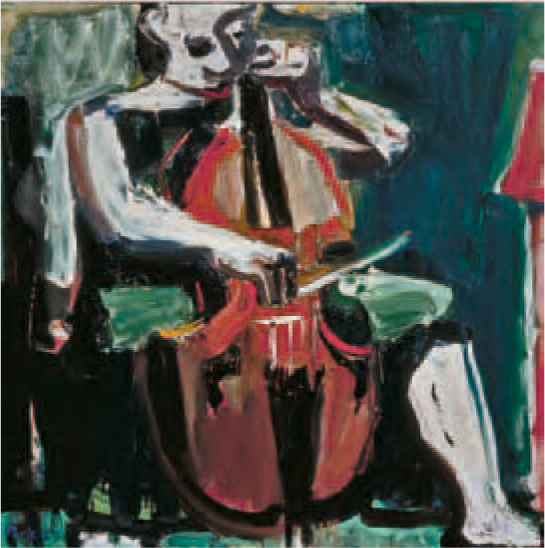
The Cellist, 1959 (fig. 86)
1960
“He knew the chips were down and he held nothing back.”
RICHARD DIEBENKORN, in Paul Mills, David Park, A Retrospective Exhibition (San Francisco: Maxwell Galleries, 1970).
Felt-tipped markers are given to Park during his convalescence and hoped-for recovery from back surgeries, and in the first months of 1960 he draws on typing paper laid on a tray stretched across his bed. Tired of the small sheets, he asks for something larger and is given a roll of shelf paper about thirty feet long. In the form of a scroll, he draws what might be seen as the great city parks of his life: Boston Common, Central Park in New York City, and San Francisco’s Golden Gate Park. The scroll is purchased and later given to the University of California. In the late spring of 1960 Park’s back problems are diagnosed as terminal bone cancer. He is told he has from three to six months to live. He sends for gouache paints and watercolor paper, and during the last months of his life, in excruciating pain, he paints about a hundred gouaches. He dies on September 20, 1960.
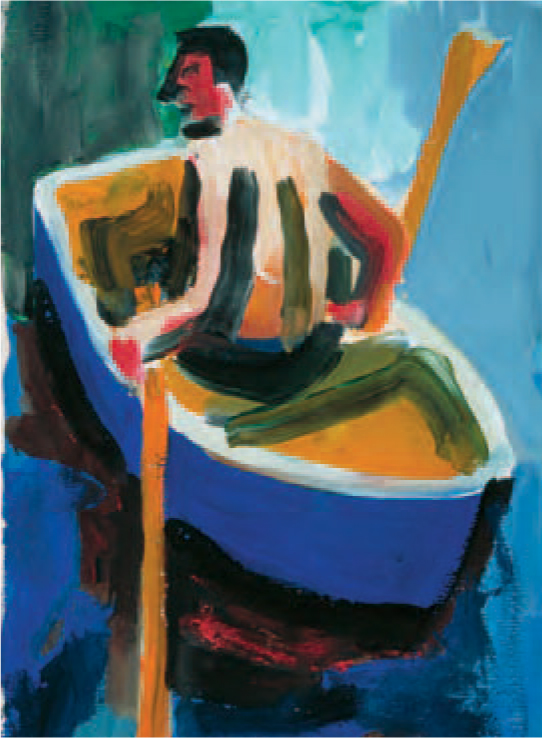
Man in Rowboat, 1960 (fig. 89)
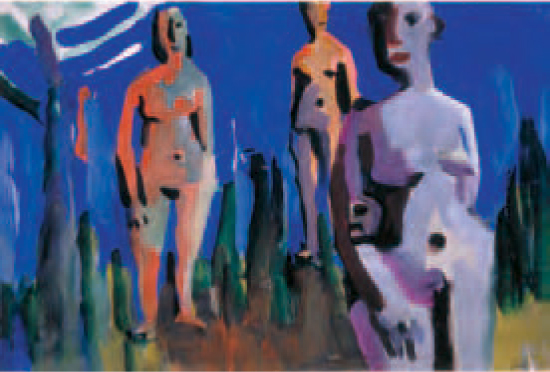
Three Women Standing, 1960 (fig. 92)
AFTERWARD: 1961–PRESENT
“Adolph Gottlieb once wrote that people are always crying for a return to the figure, but no one seems to be interested in going forward to it. I suggest that this was exactly David Park’s genius.”
HENRY GELDZAHLER, in exhibition catalogue David Park (1911–1960) (New York: Salander-O’Reilly Galleries, 1987).
“And no matter how distorted some of his figures appear, it is in their human qualities—the paradoxes that Park so movingly explores . . . that we are reminded of ourselves.”
LANCE ESPLUND, in exhibition catalogue David Park, Works on Paper 1930–1960 (San Francisco: Hackett-Freedman Gallery, 2008).
In the years following Park’s death his work is exhibited widely in solo shows at La Jolla Art Center; Artists Cooperative Gallery, Sacramento; Staempfli Gallery, New York; University Art Gallery, University of California, Berkeley; E. B. Crocker Art Gallery, Sacramento; San Jose State College Art Department; Santa Barbara Museum of Art; Maxwell Galleries, San Francisco; Adele Bednarz Galleries, Los Angeles; Newport Harbor Art Museum, Newport Beach, CA; Salander-O’Reilly Galleries, New York; Stanford University Museum and Art Gallery, Palo Alto, CA; Whitney Museum of American Art, New York; Palo Alto Cultural Center; and Hackett-Freedman Gallery, San Francisco.
Group shows include San Francisco Museum of Art; Art Institute of Chicago; Institute of Contemporary Art, Boston; Whitney Museum of American Art, New York; Amon Carter Museum, Fort Worth, TX; Oakland Museum of California; Museum of Fine Arts, St. Petersburg, FL; Haus der Kunst, Munich, Germany; Terra Museum of American Art, Evanston, IL; P.S. 1, Long Island City, NY; Berkeley Art Museum, Berkeley; Staempfli Gallery, New York; Crocker Art Gallery, Sacramento; The American Embassy, London, England; Yale University Art Gallery, New Haven, CT; San Jose State College Art Gallery; San Jose, CA; Stanford Museum and Art Gallery, Palo Alto, CA; Palo Alto Art Center, Palo Alto, CA; Salander-O’Reilly Galleries, New York; Santa Barbara Museum of Art; Newport Harbor Art Museum, Newport Beach, CA; di Rosa Preserve: Art & Nature, Napa, CA; Bellagio Gallery of Fine Art, Las Vegas, NV; and Hackett-Freedman Gallery, San Francisco, which represents Park’s work.
SELECTED PUBLIC COLLECTIONS
Berkeley Art Museum; Corcoran Gallery of Art, Washington, D.C.; Crocker Art Museum, Sacramento, CA; di Rosa Preserve: Art & Nature, Napa, CA; Fine Arts Museums of San Francisco; Hirshhorn Museum, Washington, D.C.; Hunter Museum of American Art, Chattanooga, TN; Iris & B. Gerald Cantor Center, Stanford University, Palo Alto, CA; Krannert Art Museum, Urbana-Champaigne, IL; Metropolitan Museum of Art, New York; Museum of Fine Arts, Boston; Museum of Modern Art, New York; Newport Harbor Art Museum, Newport Beach, CA; Oakland Museum of California; Portland Art Museum, Portland, OR; San Francisco Museum of Modern Art; Santa Barbara Museum of Art; Sheldon Memorial Art Gallery, Lincoln, NE; Smithsonian American Art Museum, Washington, D.C.; The Chrysler Museum, Norfolk, VA; Whitney Museum of American Art, New York.